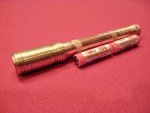Great Lifetime, we are excited to here. But remember, it is pyrolytic graphite that we are after... normal solid graphite has levels half as low as aluminum for heat transfer. The real advantage of graphite will be it's lightness... such as pocket builds. If you find a piece of round pyrolytic graphite I will fund the purchase and you can experiment with it and let us know the results!!! PM me and I will wire you money over paypal

I wonder about a PGS and copper sheet rolled heat sink. They could be rolled on a dowel quite easily, and that will enable those that don't have CNCs or drill presses to make a great homemade heatsink

And
Hi guys
I'm not a material expert, but i do curious about all these
My question is, what is the use of super high conductivity material is the surface itself is rough and thus minimizing the heat transfer?
This is only my logical thinking, doesn't those graphite very brittle and making it porous after machining? even with some surface polishing?
I always use some CPU thermal compound between the diode module and copper/aluminum heatsink,
regarding about these PGS material, what if the heatsink compound only act as a thermal resistance even if it filled the (porous) gaps??
It would be great if we managed to create pen host made using these PGS tube
8W NUBM44 with 30sec duty is all good (but ofc it's very dangerous, so no, yeah)
Let say 1.5W 520nm in a pen host with 100% duty, running 2x 14500. sweet!
The trouble with PGS is it is not too durable on the outside... it will eventually wear when put in the pocket with keys, knives, flashlights and other things we love. Also, it just transfers the heat (super super fast) from the diode... so we still need to get it in the air somehow, oh and not burn our hands too! I think it could be done, but we would need a very dense fin design and the end of the pen would have to be at least 2cm wide...:thinking:






